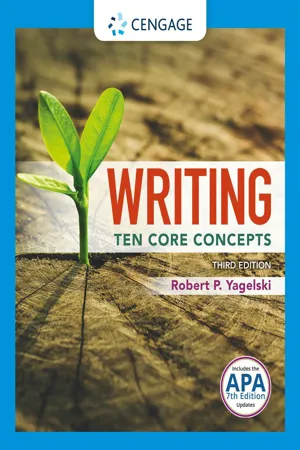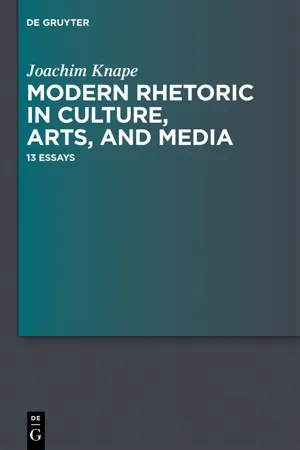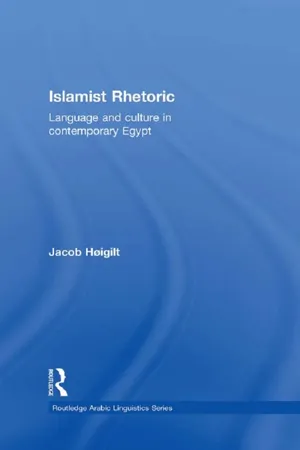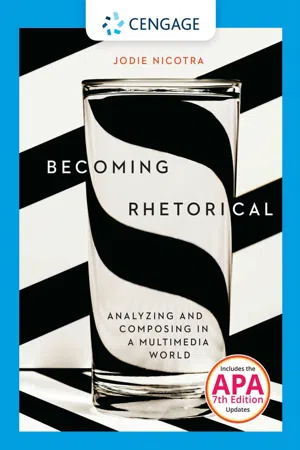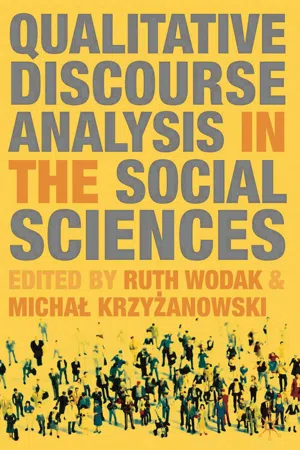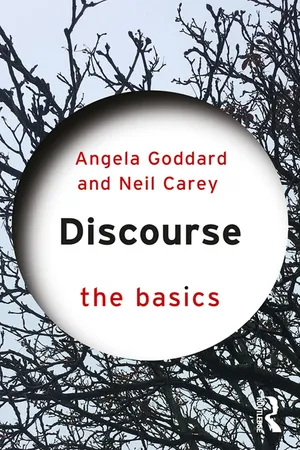Languages & Linguistics
Rhetorical Analysis
Rhetorical analysis is the examination of how language is used to persuade and influence an audience. It involves analyzing the strategies and techniques employed in written, spoken, or visual texts to understand their intended impact. This process often involves dissecting the use of language, structure, and appeals to emotion or logic to uncover the underlying persuasive elements.
Written by Perlego with AI-assistance
Related key terms
1 of 5
9 Key excerpts on "Rhetorical Analysis"
- Robert Yagelski(Author)
- 2021(Publication Date)
- Cengage Learning EMEA(Publisher)
Rhetorical Analysis illuminates the impact of a speech, image, video, song, advertisement, or essay by examining the characteristics and strategies that make a text persuasive (or not) within the rhetorical situation. Through rhetori- cal analysis, we can better understand why the statements of a public figure might resonate with people and explain how elements such as language and imagery lend persuasive power to a speech. We can also examine the historical and political context to illuminate how a speech might play a role in the public’s reaction to a significant development like a pandemic. Because Rhetorical Analysis explains how a text affects an audience, it can be a powerful tool, not only for academic assignments but also in our lives as consumers, citizens, and workers. Occasions for Rhetorical Analysis If you have ever thought about what makes a particular television commercial so popular, a hit song so catchy, or a movie so engrossing, you have engaged in a kind of Rhetorical Analysis. For instance, you might have discussed with some friends why you find a certain scene in a popular horror movie so memorable. Examining how camera angles, music, and plot twists make the scene frightening Conducting Rhetorical Analysis Copyright 2022 Cengage Learning. All Rights Reserved. May not be copied, scanned, or duplicated, in whole or in part. Due to electronic rights, some third party content may be suppressed from the eBook and/or eChapter(s). Editorial review has deemed that any suppressed content does not materially affect the overall learning experience. Cengage Learning reserves the right to remove additional content at any time if subsequent rights restrictions require it. 226 Chapter 8 | Conducting Rhetorical Analysis helps you appreciate the director’s expertise and better understand filmmaking in general. Such informal analysis can enhance the aesthetic enjoyment of a movie or song. But you might also have reason for more formal Rhetorical Analysis: 1.- eBook - PDF
- Joachim Knape, Alan L. Fortuna(Authors)
- 2012(Publication Date)
- De Gruyter(Publisher)
Likewise, students of language have often been reluctant to integrate their theories of language structure with what is manifestly the paradigm function of language, that of communication. Knowing what language does has commonly been thought to be superfluous to knowing what language is. While this attitude has begun to fade, the term language has been so thoroughly appropriated by the technical structural interests of sentence grammarians that any effort to study the use of language or the structures of language beyond the sentence requires use of a whole new term: discourse. Discourse analysis is an effort to close the gap between conceptions of communication process and language structure and function.” 41 “And what role does rhetoric play in this context?” Lévi-Strauss asks, turn- ing to me. “We still do not know what it is, specifically, that you want to examine in the marketplace of our islanders.” I answer, “first of all I want to watch the fifth scene, that is, the scene in which the man is standing in front of a group. This scene reminds me of a classical rhetorical speech-situation: an orator is trying to influence a group of people. As a result, his listeners carry out a certain action by following him away from the market. But the bartering women in the second scene (if they are really bartering), the competing melon-sellers in the third scene and the conversation in the fourth scene are interesting, too. In all of these instances an analysis might show that we are dealing with persuasion, i.e. that during the course of the communication, one or the other speaker is trying to impose his own point of view or his own intentions through the use of persuasive speech. In short, my observation focuses on the rhetorical factor in communi- cation. This factor is the phenomena of persuasion, with all its implications. - eBook - PDF
Rhetorical Analysis
An Introduction to Biblical Rhetoric
- Roland Meynet(Author)
- 1998(Publication Date)
- Sheffield Academic Press(Publisher)
By way of a conclusion, I will attempt to say briefly to what school of thought, or to what science, Rhetorical Analysis could be linked. It will allow me to specify certain notions and certain operations to which Rhetorical Analysis pays special attention. Before showing in what way Rhetorical Analysis can be linked or be said to be part of modern or structural linguistics, it is necessary to recall that at the beginning it was not born out of linguistics. Let us say, to cut a long story short, that it was marked from its very origins by anglo-saxon empiricism, that of its true founders, R. Lowth in the middle of the seventeenth century and mostly J. Jebb and T. Boys at the beginning of the nineteenth century, even if Lowth makes references to the Italian rabbi Azarias dei Rossi and if Jebb and Boys take after the remarks of the German J.A. Bengel on the parallel and concentric structures. Born long before structural linguistics, Rhetorical Analysis can be considered, not only as being linguistic, but also as being part of linguistics, as constituting the last degree of linguistic organization. 4. Presuppositions of Rhetorical Analysis 181 I have explained all of this elsewhere and I will not repeat myself here. 17 Outflowing from the first presupposition, namely that a biblical book constitutes an organic whole, one of the major operations of Rhetorical Analysis will be to identify the relevant literary units, at all levels of organization of the text. In other words, as for the identi-fication of phonemes, morphemes and lexemes, propositions and sentences, in linguistics, Rhetorical Analysis resides in finding proce-dures which will enable the cutting up, in a more scientific or at least more objective manner, of the text in its diverse units and to deter-mine the function of each of those units in the whole. - eBook - ePub
Islamist Rhetoric
Language and Culture in Contemporary Egypt
- Jacob Hoigilt(Author)
- 2013(Publication Date)
- Routledge(Publisher)
2 Rhetorical Analysis and the study of social realityBy the text linguistic approach that is the methodological mainstay of this book I seek to connect rhetoric and social reality. This necessitates an at times rather technical analysis, so a somewhat detailed description of the conceptual apparatus is in order before embarking on the analysis.Rhetoric
Rhetoric is both an object of study and a category of analysis in this book. Let me explain both functions. Originally, rhetoric meant the civic art of public speaking in the Greek city-states (Kennedy 1994: 3), but the scope and use of the term have widened dramatically, especially since the new interest in it from the latter half of the twentieth century. For the purposes of this book, it is useful to turn to Peter Dixon's definition of a rhetor as ‘a man skilled in speaking who addresses a public audience in order to make an impact upon it’ (Dixon 1971: 2). If we include the word ‘writing’ in addition to ‘speaking’, this definition covers the three rather diverse discourses under study here. ‘Amr Khālid, Yūsuf al-Qaraḍāwī and Muḥammad ‘Imāra make an impact in the Egyptian Islamic space as writers and speakers, each in their own way. They address the Egyptian and Arab public with the aim of influencing their actions and/or beliefs, and seem to have considerable success in this enterprise. Further qualifications are, however, necessary, considering the fact that the scope of rhetoric has become so wide that it can embrace the ‘entire area of human discourse’ (Dixon 1971: 2). Already in the fourth century BC , Aristotle distinguished between three areas of persuasion: deliberative, judicial and epideictic (concerned with demonstrating someone's or something's excellence; Aristotle 1991). In a modern context, Robert and Susan M. Cockcroft's (1992) distinction between literary and functional - eBook - PDF
- Jodie Nicotra(Author)
- 2018(Publication Date)
- Cengage Learning EMEA(Publisher)
All Rights Reserved. May not be copied, scanned, or duplicated, in whole or in part. Due to electronic rights, some third party content may be suppressed from the eBook and/or eChapter(s). Editorial review has deemed that any suppressed content does not materially affect the overall learning experience. Cengage Learning reserves the right to remove additional content at any time if subsequent rights restrictions require it. CHAPTER 3 Analyzing Textual Rhetoric 61 It’s important to understand that research might look very different depending on what you’re researching. If I were researching the context of a historical speech, for instance, I’d need to do a lot more research on specific historical circumstances. 3d Doing a Rhetorical Analysis of a Written Text Why would one want to write out a Rhetorical Analysis? Except for perhaps in news analyses ( The New York Times publishes these about once a week) or in bits and pieces by bloggers and satirical talk show hosts like Trevor Noah, it’s a genre not seen very often outside academia. However, as we’ll see in later chapters, Rhetorical Analysis is valuable as a means to an end. The kind of deep, sustained analysis we do here will help us to understand the conventions of genres that we’ll be writing in. It also serves practical purposes; for instance, public relations consultants typically analyze the marketing and communication materials of clients to understand how they perceive their audience and help them make better, more appropriate appeals. Most importantly, it gives us a richer sense of the possibilities for how we might rhetorically intervene. When you’re doing a Rhetorical Analysis of any sort, it’s not enough to just point out an instance of a rhetorical appeal. You have to create what we might call an analytical circle by linking your observations back to the text’s purpose. The following steps walk you through how to do this. - Ruth Wodak, Michal Krzyzanowski, Ruth Wodak, Michal Krzyzanowski(Authors)
- 2017(Publication Date)
- Red Globe Press(Publisher)
Following the above explication of rhetoric, we can conclude that rhetori-cal analysis means to analyze the employment and effects of linguistic (includ-ing nonverbal ) and other semiotic means of persuasion in rhetorical terms. The second step in answering the question of what political rhetoric denotes consists of explaining the meaning of political . The most simple explanation states that everything politicians do in pursuance of their pro-fession can be ascribed the attribute of being political. Such a conception of the political implies that political rhetoric is rhetoric produced by politi-cians. This understanding neglects the fact that political matters enter the life of everyone, that non-politicians also produce political rhetoric in pri-vate contexts, and that – as has particularly been shown by feminist critique – a rigid binary opposition of the private and the public-political sphere is untenable. Thus, we have to keep a broader understanding of the political in mind. However, in the given context, we can just focus on prototypical political rhetoric, that is rhetoric employed by politicians. For this chapter’s purpose, the analysis of political rhetoric will therefore be conceived of as an analysis of the use of rhetorical means of persuasion by professional politicians . The politolinguistic approach Politolinguistics assumes a transdisciplinary perspective. It combines rhetoric, political science and linguistics (especially critical discourse analysis – see Reisigl and Wodak 2001; Reisigl 2003). Politolinguistics theoretically differen-tiates among three different dimensions of the political : polity, policy and pol-itics (Meyer 2000:52–99). MARTIN REISIGL 97 The dimension of polity constitutes the formal and structural framework as being the basis of political action.- eBook - PDF
Doing Internet Research
Critical Issues and Methods for Examining the Net
- Steve Jones, Steven Jones(Authors)
- 1998(Publication Date)
- SAGE Publications, Inc(Publisher)
Acknowledging that communications departments also employ Rhetorical Analysis, I can testify only to the ways Rhetorical Analysis has been developed in English literature departments. 3. Poststructuralist approaches to textual analysis are more common in literary circles than in rhetorical ones. However, instances of Rhetorical Analysis that can be termed deconstructive, for example, are nonetheless still structured as justificatory arguments whose warranting as-sumptions (derived from the work of de Man, Derrida, or others) justify the claims being made by determining the relevance of the evidence brought to bear on the claims made. 4. Stephen Toulmin's Uses of Argument became a leading analytic tool in rhetorical analyses shortly after its publication in 1958. 142 DOING INTERNET RESEARCH 5. A similar phenomenon occurs in literary criticism. Many disciplines in the humanities depend on interpretation, and their mode of argumentation generally is employed to justify particular interpretive claims. In a spectrum analysis of disciplinary warrants, the warrants used to justify interpretive claims are restrictive models-^/ texts that have a template character. However, many interpretations de facto depend more on figures than on concepts as their warranting assumptions. For example, various schools of interpretation or criticism employ conceptual warrants with a high degree of metaphoricity. Perhaps the most famous metaphorical warrant is the one that stipulates that a text is organic. Other familiar ones are the unconscious is a language, texts are silent, and so on. 6. This distinction was proposed by Jean Piaget (1963). 7. I draw this description of surfing from my Hyper-readers and their Reading Engines (Sosnoski, in press) where I elaborate on the various features enumerated here. - eBook - PDF
- Prof. Nancy H. Hornberger, Dr. Sandra Lee McKay, Nancy H. Hornberger, Sandra Lee McKay(Authors)
- 2010(Publication Date)
- Multilingual Matters(Publisher)
This increase generated a need for instruc-tional support to integrate these students into the academic community in English. Contrastive rhetoric was proposed in this historical context. Contrastive analysis and error analysis Another historical context that needs to be taken into account is the general trend of research inquiry into second language study at that time. In the 1950s and 1960s, contrastive analysis, as represented by the work of Lado (1957), emerged against the backdrop of behaviorism, which was at that time influential in the field of psychology (Gass & Selinker, 2001). In contrastive analysis, language learning was understood as habit forma-tion involving sets of stimulus and response (e.g. hearing a word and pointing to the referent object or seeing an object and uttering the word). Learning a second language meant replacing a set of previous habits that the learners have developed in their L1 with a new set of habits. In this framework, comparing and contrasting the structures of L1 and L2 was considered to provide useful information for helping L2 learners establish new habits. Contrastive analysis emerged in this context with a strong pedagogical interest. Although contrastive analysis, as influenced by behaviorism and the field of linguistics at that time, was concerned with spoken language, contrastive rhetoric was clearly influenced by this con-ceptual and methodological framework. Assumptions behind contrastive 272 Part 4: Language and Literacy analysis that are relevant to contrastive rhetoric can be summarized as below (see Gass & Selinker, 2001: 72–73): (1) Contrastive analysis is based on a theory of language that claims that language is habit and that language learning involves a new set of habits. (2) The major source of error in the production and/or reception of a second language is the native language. (3) One can account for errors by considering differences between the L1 and the L2. - eBook - PDF
- Angela Goddard, Neil Carey(Authors)
- 2017(Publication Date)
- Routledge(Publisher)
DISCOURSE AND RHETORIC AIMS OF THIS CHAPTER This chapter will: • explore the origins of rhetoric and our modern-day attitudes to it; • identify some rhetorical approaches to analysis; and • look at a practical example of speech-making to explore the rela- tionship between rhetoric and discourse. THE EMPHASIS OF THIS CHAPTER Beasley (2009) highlights two broad academic traditions within the US that inform contemporary interest in rhetoric and political discourse. The first of these traditions – termed ‘public address scholarship’ – is concerned with the inner workings of a speech, analysing how the rhetorical features within a text make it a great speech and how those features best convey the intention of the pro- ducer of the text. This rhetorical tradition has much in common with literary criticism and is concerned with the intentions of the speaker or source. Although attention is paid to the persuasive potential of 6 69 DISCOURSE AND RHETORIC texts, much less consideration is given to the precise effects that rhetoric may have on the audience. In contrast, the second tradi- tion, largely arising from social science scholarship and referred to by Beasley as ‘political communication’, is much more wholly focused on identifying and measuring the effects and effectiveness of rhetoric. In this second tradition it is the receiver or consumer of rhetoric that is the focus of study. This chapter draws more on the first of these traditions. Although audiences and the values embedded in their wider cultural contexts are seen in this chapter as important factors in analysing rhetoric, less attention is given to the ‘media effects’ and ‘audience studies’ approaches that are more closely aligned with the second tradition.
Index pages curate the most relevant extracts from our library of academic textbooks. They’ve been created using an in-house natural language model (NLM), each adding context and meaning to key research topics.
